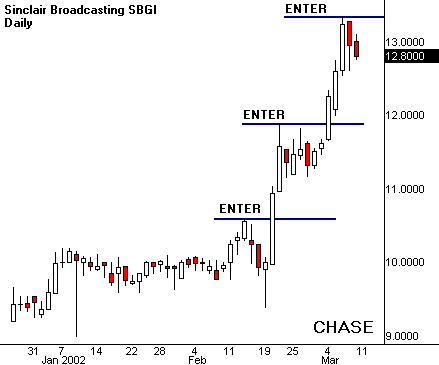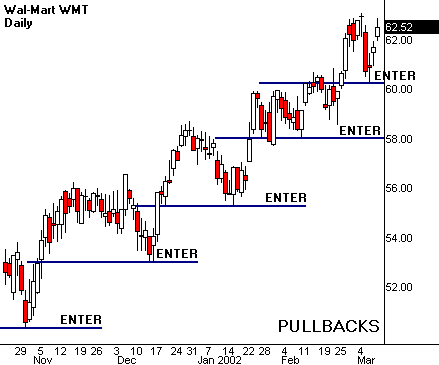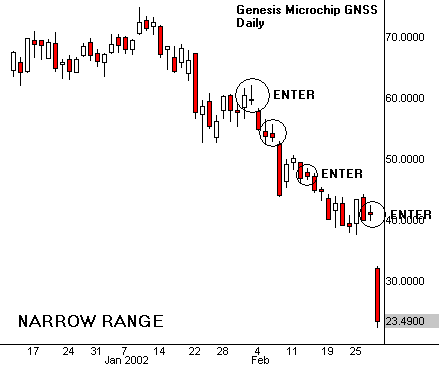I publish hundreds of trade setups each month. But none of these ideas will put money in your pocket without good timing. It's a critical error to enter a trade just because it has a pretty chart. The opportunity comes only when you can discover and capitalize on the setup's timing signals.
Careful entry bridges the gap between the setup and the trade. This is the door through which you take on monetary and emotional risk. There are many ways to time the market, but three strategies work for most swing trades. First, enter a breakout or breakdown after it's under way. Second, wait for a pullback and enter near support/resistance. Third, buy or sell within a narrow range before the move begins.
Which is the best entry strategy for your next trade? Unfortunately, the right answer is never the same twice. Don't try to render entry rules into simple repetitive tasks. In truth, you need to plan each trade within the context of the current market environment, reward-to-risk ratio and chosen holding period. This extra effort is a necessity, not a luxury.
Let's examine these three entry strategies. Over time you'll learn how to pick the best one for the trade you're ready to make. Keep in mind that several different strategies might work with the same setup. The right choice could have more to do with intestinal fortitude than market timing.

Buying a breakout or selling a breakdown is the only timing method employed by most traders. Unfortunately, it's also the best way to wash out of the markets. This entry technique is simple. Your setup breaks through support or resistance, so you rush in to place a position. And then you pray.
This is a very risky way to enter the market. The trade looks great when it moves in your direction, but what do you do if it reverses and takes off the other way? Amazingly, most folks don't have a good answer to this important question. So they freeze like a deer in the headlights when faced with the reality.
Chasing momentum can work if traders choose their plays wisely and pay close attention to two important rules. First, always establish your risk before making the trade. Choose a flat stop-loss percentage, or use a pattern in a lower time frame to signal when the trade goes against you. Second, make sure the broader market offers adequate support for your strategy. Momentum stocks benefit from momentum markets.

What's your rush? Many traders believe they're too late when they stumble across a breakout in progress. In fact, they're often too early. Many times you're better off standing aside and waiting for the market to reverse, rather than jumping in with the crowd. Pullback entry is a very powerful method because it uses the eager capital of those who missed the first move. But the trick is to get into the trade before they do, and let their enthusiasm carry you into a profit.
Pullback entry is very price-sensitive. If possible, place a limit order where you expect the pullback to shift toward the breakout direction. This is actually easier than it sounds. New trends frequently return to prior support/resistance before momentum finally kicks in. So look at the chart and find where the initial breakout took place. Pullbacks often move to these important levels like magnets.
 Narrow range entry confuses many traders, but the theory is simple. Common sense dictates the best time to enter a new position is just before a breakout or breakdown. Narrow range uses characteristics of low volatility to identify when conditions are ripe for a big move. The trader enters at a tight price level and waits for a move to begin. The advantage is that the position can be exited for a small loss if the market breaks the other way.
Narrow range entry confuses many traders, but the theory is simple. Common sense dictates the best time to enter a new position is just before a breakout or breakdown. Narrow range uses characteristics of low volatility to identify when conditions are ripe for a big move. The trader enters at a tight price level and waits for a move to begin. The advantage is that the position can be exited for a small loss if the market breaks the other way.Congestion patterns, such as triangles, often look like coiled springs. Paradoxically, this wound-up appearance predicts the return of rapid price movement. Traders can use classic indicators, such as historical volatility, to identify trigger points for this movement. But a better way is to locate narrow range bars and declining volume right at key support/resistance levels. Enter the trade here while everyone else gets ready to chase the breakout or breakdown.


1 comments:
Theres alot of money to be made in forex trading just have to go out in get it.
Forex Day Trading
Post a Comment